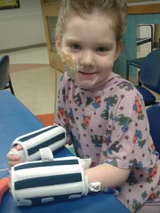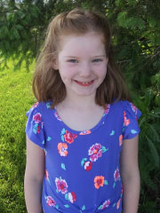Treatment for Recurrent Pancreatitis and Choledochal Cysts: Autumn's Story
Treatment for Recurrent Pancreatitis and Choledochal Cysts: Autumn's Story
At first, Autumn's mom thought her daughter just had a series of mild stomach viruses. But as her symptoms increased in severity, it took CHOP’s expertise to diagnose what was really happening and find the solution to get the toddler back on her feet.

As a baby, Autumn seemed perfectly healthy aside from a handful of mild stomach bugs — nothing unusual. But when she was 2 years old, she had a bout of severe stomach pain and continual vomiting that prompted a trip to the local family doctor.
At that visit, tests showed Autumn's liver enzymes were elevated. Her doctor couldn’t be sure why, but suspected the toddler had picked up a mild infectious hepatitis from contaminated food. “I wasn’t convinced that was the cause, but she got better in a few days with fluids and rest, so it seemed like it made sense,” says Hollie, Autumn’s mom.
That changed when the same severe stomach pain and vomiting returned. The episodes left Autumn feeling exhausted and Hollie worried. “She would just sit in my lap, holding her stomach with no energy to do anything,” says Hollie. Worse, the repeated episodes suggested something more chronic was the cause — not the previously suspected hepatitis.
Autumn ended up at her local hospital’s emergency department and was transferred to Children’s Hospital of Philadelphia (CHOP) for more specialized care to get to the root of her issue.
First steps to a diagnosis
“I knew nothing about CHOP at the time,” Hollie says. “But I also felt better knowing we were going to a hospital that could figure out what was wrong with her.”
Autumn was admitted to CHOP’s Division of Gastroenterology, Hepatology and Nutrition for four days, where she was treated for pancreatitis, meaning her pancreas, the organ behind the lower part of her stomach, was inflamed. Pancreatitis can cause pain, and repeated episodes can cause chronic pain and permanent damage.
Autumn was seen by Petar Mamula, MD, and Jefferson N. Brownell, MD, who worked to make her more comfortable and determine why she had repeated episodes of abdominal pain, elevated liver enzymes, and on top of that, pancreatitis.
During that first visit, Autumn’s doctors ran a series of tests including an abdominal CT and a magnetic resonance cholangiopancreatography (MRCP) to get images of Autumn’s gallbladder and pancreas. These images showed that Autumn’s common bile duct was dilated three times the normal size and several of her biliary ducts were either narrowed or dilated.
“The tests gave us some answers, but also raised more questions,” Hollie says. Autumn's case was complex. While the tests provided some indications about her condition, they didn't lead to a conclusive diagnosis. When Autumn felt well enough to eat, she was discharged and doctors encouraged her to stay well rested and hydrated.
“I hoped this would be a one-off thing," Hollie says. "But it wasn’t.”
Reoccurring pancreatitis … but why?

At a follow-up appointment at CHOP, Autumn's medical team discussed possible causes for her abdominal pain, including gallstones, pancreatic malfunction, an autoimmune disorder, some unknown genetic cause or even cystic fibrosis. But none of the possible causes was a perfect fit with Autumn's symptoms and test results, so there was still no definitive diagnosis.
Over the next few months, Autumn had two more recurrences of pancreatitis. On both occasions, she was readmitted to CHOP for treatment and further testing. The third MRCP finally gave doctors the information they needed to provide a diagnosis. Autumn had a choledochal cyst, a rare congenital anomaly in which the bile duct and pancreatic duct join in the wrong place, hindering the normal flow of bile from the liver and digestive juices from the pancreas. This abnormal flow had been causing her recurrent pain episodes with pancreatitis and elevated liver enzymes.
Treating choledochal cysts with bile duct surgery
Now that doctors could see the cause, they could devise an effective treatment for Autumn: She was scheduled for bile duct surgery with Alan W. Flake, MD, FACS, FAAP, a week later. During the surgery, Dr. Flake repaired the ducts to improve the flow of bile from Autumn’s liver to her intestine.
“I was so relieved they found an answer and had a plan for it,” says Hollie. “I was nervous about the surgery, but Dr. Flake took the time to explain everything to me in a way I could understand,” she says. “And our other doctors had told us he was one of the best in the world. I had a lot of trust in their opinion.”
“I don’t think we would have gotten the same kind of care anywhere else.”
“CHOP has the expertise. My local hospital knew enough to send us someplace that could take care of this,” Hollie continues.
For her part, Autumn was too young to really understand what was happening, but Hollie says that between visits from Child Life (specially trained staff who provide care and support to help children and families cope) and the chance to indulge in TV —something she didn’t usually get at home — Autumn seemed to enjoy her hospital stay.
“I wanted to shield her from what was going on,” Hollie says. “Child Life was great in helping her relax. She especially loved the toy room, the visiting musician and seeing the therapy dog.”
The surgery took several hours, but Autumn came through with flying colors. Recovery took six days in the hospital and another week at home sticking to low-impact activities. “She had an NG tube at first and was pretty sore, but she was back to herself after a few days,” says Hollie.
More importantly, in the three years since, Autumn hasn’t had a single flare up of pancreatitis.
Autumn today

Today, Autumn is a happy, energetic 7-year-old who loves to swim and play with dolls. Aside from a scar on her abdomen, there’s little indication of her battle with recurrent pancreatitis — she takes no medications and has no restrictions on her diet or activities. In fact, Hollie says Autumn seems to have little memory of ever being sick.
Autumn still has checkups with Drs. Mamula and Brownell, because kids who have had choledochal cysts are at higher risk of cancer when they are older. Annual bloodwork and an ultrasound let the doctors monitor her progress and ensure she remains healthy.
Hollie says she's grateful CHOP was able to help Autumn resolve what could have been a debilitating condition. “All I want is for her to have a happy, healthy life.”
“I am so grateful that there are people so skilled and knowledgeable to be able to do this. It’s a huge blessing to have CHOP in our area.”